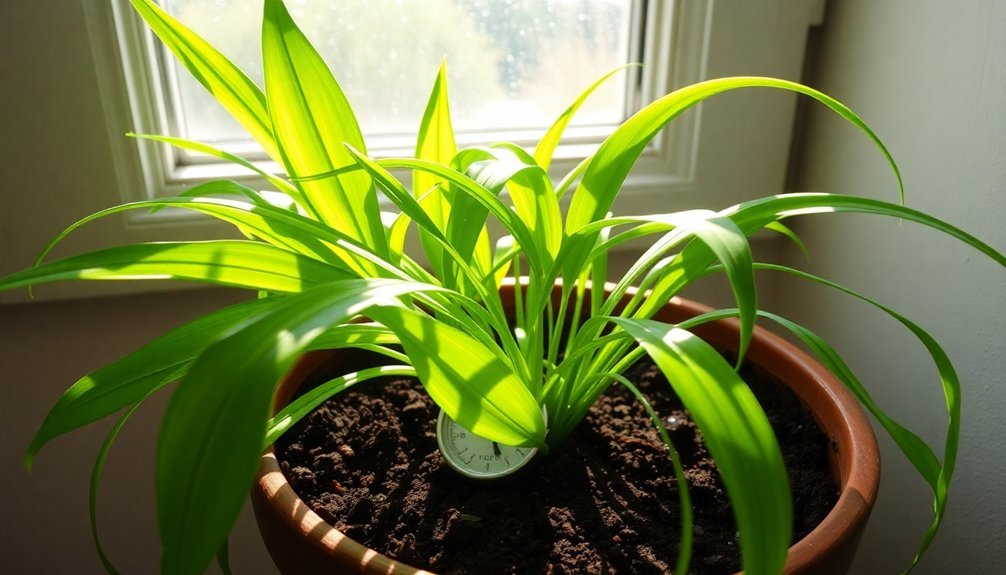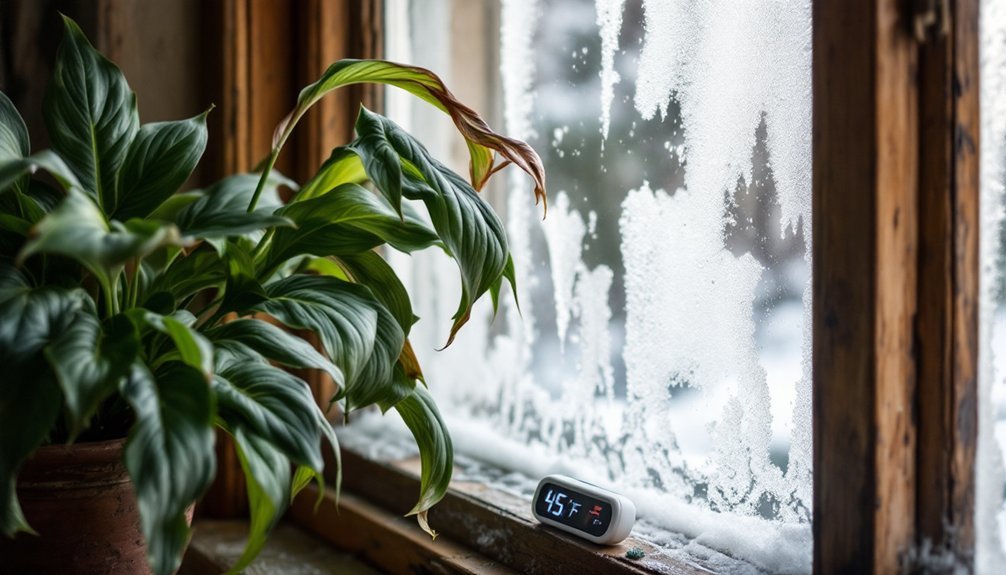Spider plants thrive in humidity levels between 40% to 60%, but they'll tolerate up to 80% with proper air circulation. You'll know your plant needs more moisture if you notice brown leaf tips or drooping foliage. Keep a hygrometer nearby to monitor levels, and consider using a pebble tray or humidifier to maintain ideal conditions. Group your spider plants with other humidity-loving species to create a naturally moist environment. Our complete guide offers proven techniques to master your plant's moisture needs.
Understanding Your Spider Plant's Natural Humidity Needs

While spider plants are known for their adaptability, they truly flourish in environments that mirror their natural habitat's humidity levels of 40% to 60%.
Understanding your spider plant needs starts with recognizing how consistent humidity supports its essential functions, including transpiration and nutrient absorption.
You'll want to maintain stable humidity in your indoor environments to prevent leaf browning and promote ideal growth.
Keep in mind that your spider plant thrives alongside other humidity-loving plants, which can naturally help maintain moisture levels in the air.
To stay on top of your plant's moisture requirements, you'll need to start monitoring with a hygrometer regularly.
This simple tool helps you track and adjust humidity levels before any signs of stress appear, promoting your spider plant's vibrant appearance and healthy growth pattern.
Signs Your Spider Plant Needs More Moisture
Vigilant plant parents can spot several telltale signs when their spider plant craves more humidity. Brown leaf tips are often the first indicator that your Spider Plant is struggling with low humidity levels.
You'll notice your plant's leaves becoming droopy or wilting when there isn't enough moisture in the air.
Watch for curling leaves and crispy edges, as these symptoms suggest your plant is in distress from insufficient humidity.
If your home's humidity falls below 40%, your Spider Plant won't thrive as it should.
To stay ahead of these issues, you'll want to invest in a hygrometer to monitor moisture levels. This simple tool helps you maintain the ideal 40-80% humidity range, ensuring your Spider Plant remains healthy and vibrant before visible signs of stress appear.
Measuring and Monitoring Humidity Levels

Tracking your Spider Plant's humidity levels requires both the right tools and consistent monitoring practices. A hygrometer is your best ally in maintaining the ideal humidity range of 40% to 80%, with 40-60% being most suitable for robust growth.
You'll want to monitor humidity regularly, as your Spider Plant will show clear signs when moisture levels aren't right. Watch for plant responses like leaf droopiness or browning leaf tips, which signal humidity problems that need your attention.
To stabilize moisture in your indoor environment, try grouping plants together – this creates a beneficial microenvironment that helps maintain steady humidity levels.
Creating the Perfect Humidity Environment
Building on your monitoring practices, you'll need specific strategies to establish the right humidity environment for your Spider Plant. To maintain suitable humidity between 40% and 60%, try grouping multiple plants together to benefit from communal transpiration. This natural process helps increase humidity and promote healthy growth.
You can boost moisture levels by misting leaves regularly or setting up a pebble tray filled with water beneath your plants.
As you work to create the ideal humidity conditions, don't forget about good air circulation. Proper airflow prevents excess moisture from accumulating, which could lead to root rot and other problems.
While implementing these methods, continue to monitor indoor humidity levels with your hygrometer, adjusting your approach as needed to keep your Spider Plants thriving.
Seasonal Adjustments for Optimal Moisture

Your Spider Plant's humidity needs shift dramatically with the seasons, requiring different care approaches throughout the year.
In spring and summer, you'll need to monitor moisture levels closely and may need to reduce indoor humidity when it exceeds 60%, while grouping plants together can help maintain ideal conditions naturally.
During winter's dry spells, you'll want to use a humidifier and regularly mist your plant to keep humidity levels from dropping below 40%, preventing those unsightly brown leaf tips.
Spring Humidity Control Tips
When spring arrives, Spider Plants awaken from their winter dormancy and require careful attention to humidity levels for healthy growth.
You'll want to maintain humidity between 40-60% to support your plant's active growth phase. As temperatures rise, use a humidifier or mist the leaves regularly to prevent brown tips from developing.
Keep track of moisture levels with a hygrometer, as spring's variable weather can affect indoor conditions.
You can boost humidity naturally by grouping your Spider Plants with other houseplants, which increases transpiration and creates a more stable environment.
While maintaining proper moisture, don't forget about drainage – let the soil dry slightly between waterings to prevent root rot, especially when humidity is high.
This balance guarantees your Spider Plants thrive during their spring growth spurt.
Summer Moisture Management Techniques
The summer season presents unique challenges for maintaining ideal moisture levels in Spider Plants.
You'll need to monitor indoor humidity consistently to keep your plants thriving in the 40-60% range, which promotes healthy growth while preventing leaf tip browning and root rot.
To achieve best moisture management, use a humidifier or group your spider plants together, creating a natural humidity-boosting environment through communal transpiration.
While misting foliage can provide quick relief, don't overdo it, as excess water on leaves may trigger fungal diseases.
During particularly humid periods, deploy fans or dehumidifiers to maintain balanced moisture levels.
Keep a hygrometer handy to track humidity levels, especially during hot, dry spells.
Winter Dryness Prevention Methods
Maintaining ideal humidity levels during winter months requires different strategies than summer care, as indoor heating systems can drastically reduce moisture in the air. To prevent winter dryness, you'll need to monitor conditions using a hygrometer and keep indoor humidity between 40-60% for your spider plants.
| Method | Benefits |
|---|---|
| Humidifier | Consistent moisture control |
| Pebble Trays | Localized humidity increase |
| Plant Grouping | Enhanced transpiration |
Combat dry conditions by placing pebble trays near your plants or using a humidifier for more consistent results. While misting can provide quick relief, use it sparingly to avoid moisture buildup. Group your spider plants together to create a microclimate that supports better humidity through communal transpiration. Remember to adjust your watering schedule, allowing the top soil to dry between waterings to prevent root rot while maintaining proper moisture levels.
Balancing Humidity With Other Care Requirements

Your spider plant's humidity needs directly connect to its light exposure, as brighter conditions increase water usage and evaporation rates.
When placing your plant in bright, indirect light, you'll need to maintain consistent humidity levels between 40-60% to prevent leaf tip browning and stress.
The type of soil mix you choose plays an essential role too, as well-draining potting media helps balance moisture retention while allowing excess water to escape, creating an environment where proper humidity levels can be maintained.
Light Affects Moisture Needs
Because spider plants respond dynamically to light conditions, you'll need to adjust their moisture requirements accordingly. In bright, indirect light, your spider plant will transpire more actively, requiring careful attention to both humidity and watering frequency. These conditions promote healthy moisture circulation while preventing excess water from lingering in the soil.
If you've placed your plant in lower light areas, you'll notice it needs less water since its growth and moisture uptake slow down. Watch for warning signs like browning leaf tips or droopy leaves, which indicate an imbalance between light and humidity.
To prevent root rot, maintain humidity levels between 40% to 60% and guarantee adequate light exposure. This balance is essential – insufficient light combined with high humidity can lead to leggy growth and potential root problems.
Soil Mix Impacts Humidity
While spider plants thrive in a range of humidity levels between 40-80%, the right soil mix plays an essential role in maintaining suitable moisture balance. Your soil choice directly affects how humidity interacts with your Spider Plants, impacting their overall growth and health.
- Choose well-draining soil mixed with perlite to prevent root rot in high humidity conditions.
- Monitor soil moisture regularly to guarantee proper balance between drainage and moisture retention.
- Adjust your watering routine based on how your soil mix responds to ambient humidity levels.
When your soil mix retains too much moisture, you'll notice droopy leaves and potential root rot. Conversely, if your soil drains too quickly, brown leaf tips may appear.
Troubleshooting Common Humidity-Related Issues
When spider plants display signs of humidity-related stress, it's essential to identify and address the symptoms quickly.
Watch for brown tips on leaves when humidity levels drop below 40%, indicating poor moisture absorption. Conversely, if you notice root rot or droopy foliage, your plant might be struggling with excessive humidity above 80%.
To maintain consistent humidity between 40-60%, use a hygrometer to monitor moisture levels regularly. If you spot issues, adjust your plant's environment immediately.
For low humidity, consider moving plants away from heating vents or using a humidifier. When dealing with high humidity, improve air circulation with fans and use a dehumidifier if necessary.
Remember that stable conditions are key – your spider plants will thrive when you prevent extreme humidity fluctuations through regular monitoring and quick intervention.
Frequently Asked Questions
Is 70% Humidity Too High for Plants?
While 70% humidity isn't too high for most tropical houseplants, you'll want to guarantee good air circulation. It's ideal for many species, but you should watch for fungal issues if ventilation is poor.
Do Spider Plants Need a Pebble Tray?
You don't absolutely need a pebble tray for spider plants, but it's helpful in dry indoor spaces. If your home's humidity is below 40%, using one can benefit your plant's overall health.
Do Spider Plants Like to Stay Moist?
You'll want to keep your spider plant's soil lightly moist but never waterlogged. Let the top 1-2 inches dry between waterings. Don't keep the soil constantly wet, as this can cause root rot.
What Makes a Spider Plant Happy?
You'll make your spider plant happy with bright indirect light, consistent moisture, and humidity between 50-60%. Don't forget to give it well-draining soil and occasional fertilizer during growing season.
In Summary
You'll find spider plants thrive best in humidity levels between 40-60%. Keep an eye on your plant's signals, adjust moisture levels seasonally, and don't forget to balance humidity with proper watering, light, and temperature. If you're maintaining these ideal conditions, you'll be rewarded with healthy, vibrant leaves and plenty of baby spiders. When in doubt, it's better to aim for moderate humidity than extremes.





Leave a Reply